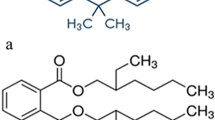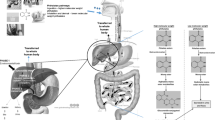Abstract
Phthalates are esters of phthalic acid used industrially as plastic additives, however, these are not covalently bound to the polymer matrix and therefore can be released to the environment. The aim of this study was to evaluate the effect of four phthalates: dibutyl phthalate (DBP), benzyl butyl phthalate (BBP), diethyl phthalate (DEP) and diethylhexyl phthalate (DEHP) on the in vitro expansion of human hematopoietic cells from umbilical cord blood. For this, 0.5 × 106 cells/mL were exposure to concentrations ranging from 0.1 to 100 μg/mL and the total cell expansion was determined after 14 days of culture in IMDM-cytokines medium. The control cultures attained 1.31 ± 0.21 × 106 cell/mL, whereas the cultures exposed to DBP, BBP and DEHP showed a reduction from 23 to 81%, 17 to 69% and 15 to 93.5%, respectively. DEP did not affect the total cell expansion. The most significant decrease on total cell expansion was observed at 0.1 μg/mL DBP, 100 μg/mL BBP and 10 μg/mL DEHP (p < 0.05). Additionally, the effect of these compounds on the expansion of hematopoietic progenitors was analyzed by clonogenic assays as colony forming units (CFU). The CFU decreased considerably compared with respect to the control cultures. The reduction was 74.6 and 99.1% at 10 and 100 μg/mL DBP respectively, whereas 100 μg/mL BBP and 100 μg/mL DEHP reduced the CFU expansion in 97.1% and 81%, respectively. Cultures exposed to DEP did not show significant differences. The results demonstrate the toxicity of DBP, BBP and DEHP on the human hematopoietic stem cells.




Similar content being viewed by others
References
Ahmad R, Gautam A, Verma Y, Sedha S, Kumar S (2014) Effects of in utero di-butyl phthalate and butyl benzyl phthalate exposure on offspring development and male reproduction of rat. Environ Sci Pollut Res 21:3156–3165
Andersen HR et al (1999) Comparison of short-term estrogenicity tests for identification of hormone-disrupting chemicals. Environ Health Perspect 107:89
Anderson D, Yu TW, Hincal F (1999) Effect of some phthalate esters in human cells in the comet assay. Teratoge Carcinog Mutag 19:275–280
Andrade PZ, Santos FD, Cabral J, Silva CL (2015) Stem cell bioengineering strategies to widen the therapeutic applications of haematopoietic stem/progenitor cells from umbilical cord blood. J Tissue Eng Regen Med 9:988–1003
Andrade-Zaldívar H, Kalixto-Sánchez M, Barba de La Rosa A, De León-Rodríguez A (2014) Expansion of CD34+ human hematopoietic cells from umbilical cord blood using roller bottles. Revista Mexicana de Ingeniería Química 13:379–385
Api A (2001) Toxicological profile of diethyl phthalate: a vehicle for fragrance and cosmetic ingredients. Food Chem Toxicol 39:97–108
Benachour N, Aris A (2009) Toxic effects of low doses of Bisphenol-A on human placental cells. Toxicol Appl Pharmacol 241:322–328
Braun JM, Sathyanarayana S, Hauser R (2013) Phthalate exposure and children’s health Current opinion in pediatrics 25:247
Cairo MS, Wagner JE (1997) Placental and/or umbilical cord blood: an alternative source of hematopoietic stem cells for transplantation. Blood 90:4665–4678
Calafat AM, McKee RH (2006) Integrating biomonitoring exposure data into the risk assessment process: phthalates [diethyl phthalate and di (2-ethylhexyl) phthalate] as a case study. Environ Health Perspect 114:1783
Chighizola C, Meroni PL (2012) The role of environmental estrogens and autoimmunity. Autoimmun Rev 11:A493–A501
De León A, Mayani H, Ramírez OT (1998) Design, characterization and application of a minibioreactor for the culture of human hematopoietic cells under controlled conditions. In: Cell culture engineering VI. Springer, pp 127–138
Genuis SJ, Beesoon S, Lobo RA, Birkholz D (2012) Human elimination of phthalate compounds: blood, urine, and sweat (BUS) study. Sci World J 2012:1–10
Gibson TP, Briggs WA, Boone BJ (1976) Delivery of di-2-ethylhexyl phthalate to patients during hemodialysis. J Lab Clin Med 87:519–524
Hays SM, Aylward LL, Kirman CR, Krishnan K, Nong A (2011) Biomonitoring equivalents for di-isononyl phthalate (DINP). Regul Toxicol Pharmacol 60:181–188
Huang Y et al (2014) Phthalate levels in cord blood are associated with preterm delivery and fetal growth parameters in Chinese women. PLoS ONE 9:e87430
Inoue K, Kawaguchi M, Yamanaka R, Higuchi T, Ito R, Saito K, Nakazawa H (2005) Evaluation and analysis of exposure levels of di (2-ethylhexyl) phthalate from blood bags. Clin Chim Acta 358:159–166
Jones AE, Kahn RH, Groves JT, Napier EA Jr (1975) Phthalate ester toxicity in human cell cultures. Toxicol Appl Pharmacol 31:283–289
Kavlock R et al (2002) NTP center for the evaluation of risks to human reproduction: phthalates expert panel report on the reproductive and developmental toxicity of di (2-ethylhexyl) phthalate. Reprod Toxicol 16:529–653
Kim S et al (2019) Di-2-ethylhexylphthalate promotes thyroid cell proliferation and DNA damage through activating thyrotropin-receptor-mediated pathways in vitro and in vivo. Food Chem Toxicol 124:265–272
Koch HM, Rossbach B, Drexler H, Angerer J (2003) Internal exposure of the general population to DEHP and other phthalates—determination of secondary and primary phthalate monoester metabolites in urine. Environ Res 93:177–185
Kostić IS, Anđelković TD, Anđelković DH, Cvetković TP, Pavlović DD (2016) Determination of di (2-ethylhexyl) phthalate in plastic medical devices. Hemijska Industrija 70:159
Kovats S (2015) Estrogen receptors regulate innate immune cells and signaling pathways. Cell Immunol 294:63–69
Krüger T, Cao Y, Kjærgaard SK, Knudsen LE, Bonefeld-Jørgensen EC (2012) Effects of phthalates on the human corneal endothelial cell line B4G12. Int J Toxicol 31:364–371
Kusk KO et al (2011) Endocrine potency of wastewater: contents of endocrine disrupting chemicals and effects measured by in vivo and in vitro assays. Environ Toxicol Chem 30:413–426
Lagerberg JW, Gouwerok E, Vlaar R, Go M, de Korte D (2015) In vitro evaluation of the quality of blood products collected and stored in systems completely free of di (2-ethylhexyl) phthalate–plasticized materials. Transfusion 55:522–531
Latini G (2005) Monitoring phthalate exposure in humans. Clin Chim Acta 361:20–29
Latini G, De Felice C, Presta G, Del Vecchio A, Paris I, Ruggieri F, Mazzeo P (2003) In utero exposure to di-(2-ethylhexyl) phthalate and duration of human pregnancy. Environ Health Perspect 111:1783
Lin L, Zheng L, Gu Y, Wang J, Zhang Y, Song W (2008) Levels of environmental endocrine disruptors in umbilical cord blood and maternal blood of low-birth-weight infants. Zhonghua yu fang yi xue za [Chin J Prev Med] 42:177–180
Liu Y, Mei C, Liu H, Wang H, Zeng G, Lin J, Xu M (2014) Modulation of cytokine expression in human macrophages by endocrine-disrupting chemical Bisphenol-A. Biochem Biophys Res Commun 451:592–598
Louis KS, Siegel AC (2011) Cell viability analysis using trypan blue: manual and automated methods. In: Mammalian cell viability. Springer, pp 7–12
Lovekamp T, Davis B (2001) Mono-(2-ethylhexyl) phthalate suppresses aromatase transcript levels and estradiol production in cultured rat granulosa cells. Toxicol Appl Pharmacol 172:217–224
Main KM et al (2005) Human breast milk contamination with phthalates and alterations of endogenous reproductive hormones in infants three months of age. Environ Health Perspect 114:270–276
Mankidy R, Wiseman S, Ma H, Giesy JP (2013) Biological impact of phthalates. Toxicol Lett 217:50–58
Manz P, Cadeddu R-P, Wilk M, Fritz B, Haas R, Wenzel F (2014) Impact of Di (2-ethylhexyl) phthalate on migration rate of human promyelocytic leukemia cells (HL-60). Clin Hemorheol Microcirc 58:241–246
Manz P, Cadeddu R-P, Wilk M, Fischer JC, Fritz B, Haas R, Wenzel F (2015) Influence of Di (2-ethylhexyl) phthalate on migration rate and differentiation of human hematopoietic stem and progenitor cells (CD34+). Clin Hemorheol Microcirc 61:111–118
Marsee K, Woodruff TJ, Axelrad DA, Calafat AM, Swan SH (2006) Estimated daily phthalate exposures in a population of mothers of male infants exhibiting reduced anogenital distance. Environ Health Perspect 114:805
Mayani H et al (1998) Kinetics of hematopoiesis in dexter-type long-term cultures established from human umbilical cord blood cells. Stem Cells 16:127–135
Meeker JD, Sathyanarayana S, Swan SH (2009) Phthalates and other additives in plastics: human exposure and associated health outcomes. Philos Trans R Soc B: Biol Sci 364:2097–2113
Melzak KA, Uhlig S, Kirschhöfer F, Brenner-Weiss G, Bieback K (2018) The blood bag plasticizer di-2-ethylhexylphthalate causes red blood cells to form stomatocytes, possibly by inducing lipid flip-flop. Transfus Med Hemother 45:413–422
Mierzejewska K et al (2015) Hematopoietic stem/progenitor cells express several functional sex hormone receptors—novel evidence for a potential developmental link between hematopoiesis and primordial germ cells. Stem Cells Dev 24:927–937
Mortensen GK, Main KM, Andersson A-M, Leffers H, Skakkebæk NE (2005) Determination of phthalate monoesters in human milk, consumer milk, and infant formula by tandem mass spectrometry (LC–MS–MS). Anal Bioanal Chem 382:1084–1092
Pereira C, Clarke E, Damen J (2007) Hematopoietic colony-forming cell assays. In: Stem cell assays. Springer, pp 177–208
Phelan K, May KM (2007) Basic techniques in mammalian cell tissue culture. Curr Protoc Cell Biol 1.1:1–1.1.22
Phillips BJ, Anderson D, Gangolli SD (1986) Studies on the genetic effects of phthalic acid esters on cells in culture. Environ Health Perspect 65:263
Sarma NJ, Takeda A, Yaseen NR (2010) Colony forming cell (CFC) assay for human hematopoietic cells J Vis Exp 46:2195
Shaz BH, Grima K, Hillyer CD (2011) 2-(Diethylhexyl) phthalate in blood bags: is this a public health issue? Transfusion 51:2510–2517
Sicińska P (2018) Di-n-butyl phthalate, butylbenzyl phthalate and their metabolites induce haemolysis and eryptosis in human erythrocytes. Chemosphere 203:44–53
Silva MJ, Reidy JA, Samandar E, Herbert AR, Needham LL, Calafat AM (2005) Detection of phthalate metabolites in human saliva. Arch Toxicol 79:647–652
Singh S, Li SS-L (2012) Epigenetic effects of environmental chemicals bisphenol a and phthalates. Int J Mol Sci 13:10143–10153
Singh A, Lawrence W, Autian J (1972) Teratogenicity of phthalate esters in rats. J Pharm Sci 61:51–55
Staples CA, Peterson DR, Parkerton TF, Adams WJ (1997) The environmental fate of phthalate esters: a literature review. Chemosphere 35:667–749
Steiner I, Scharf L, Fiala F, Washüttl J (1998) Migration of di-(2-ethylhexyl) phthalate from PVC child articles into saliva and saliva simulant. Food Addit Contam 15:812–817
Thomas JA, Thomas MJ, Gangolli SD (1984) Biological effects of di-(2-ethylhexyl) phthalate and other phthalic acid esters. CRC Crit Reviews Toxicol 13:283–317
Tranfo G, Paci E, Pigini D, Bonanni RC, Capanna S, De Carolis C, Iavicoli S (2014) Phthalate metabolites in amniotic fluid and maternal urine samples. J Environ Prot 5:1411
Witorsch RJ, Thomas JA (2010) Personal care products and endocrine disruption: a critical review of the literature. Crit Rev Toxicol 40:1–30
Wognum B, Yuan N, Lai B, Miller CL (2013) Colony forming cell assays for human hematopoietic progenitor cells. In: Basic cell culture protocols. Springer, pp 267–283
Zhu J, Phillips SP, Feng Y-L, Yang X (2006) Phthalate esters in human milk: concentration variations over a 6-month postpartum time. Environ Sci Technol 40:5276–5281
Acknowledgements
J. Flores, T. Ortiz, A. Gutiérrez, thank the National Council of Science and Technology (CONACYT) for their scholarships 591428, 298411, 297341, respectively. We would like to thank the partial financial support from CONACyT-Fondo Sectorial SALUD 233340 and CONACyT Problemas Nacionales 2017-4601. We thank Victor E. Balderas for his technical support and the comments and Graham M. Tippett for the English revision.
Author information
Authors and Affiliations
Corresponding author
Additional information
Publisher's Note
Springer Nature remains neutral with regard to jurisdictional claims in published maps and institutional affiliations.
Rights and permissions
About this article
Cite this article
Gutiérrez-García, A.K., Flores-Kelly, J.M., Ortiz-Rodríguez, T. et al. Phthalates affect the in vitro expansion of human hematopoietic stem cell. Cytotechnology 71, 553–561 (2019). https://doi.org/10.1007/s10616-019-00300-x
Received:
Accepted:
Published:
Issue Date:
DOI: https://doi.org/10.1007/s10616-019-00300-x




